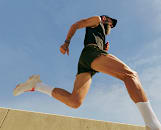
What Does It Mean to Overstride While Running? Plus, How to Dial-In Your Form
It may sound counterintuitive, but shortening your stride can boost your running performance.
By Jennifer Heimlich•
What Is Overstriding?
How Overstriding Impacts Your Running
How to Tell If You’re Overstriding
How to Reduce and Correct Overstriding
How to Increase Your Running Cadence
When It’s OK to Overstride
When Peloton instructor Hannah Frankson first got into long-distance running, she realized that she had a bit of a bad habit: overstriding. “Coming from a sprinting background, I was used to producing more force per step,” she says. This led her to take long, lengthy strides, rather than the short, quick ones that distance running coaches recommend.
Discover more ways to reach your goals with Peloton
She’s far from alone. Overstriding is one of the most common problems runners have with their gait, particularly when they’re new to covering long distances. But why is overstriding such a bad thing in distance running? And what can you do about it? Here’s what experts like Hannah want you to know if you think overstriding might be affecting your own running performance.
What Is Overstriding?
Overstriding is what happens when runners land with their foot too far in front of their center of gravity. “We’re looking at the foot strike location,” says physical therapist Lauren Glisic, co-founder of Athletic Lab Physical Therapy and Performance Training. She says that overstriders will hit the ground with their foot out in front of their torso, which typically also means their knee will be nearly fully extended and their heel will strike first. “When a runner lands, we want to see them landing with a little bit of knee flexion [i.e., bend],” she says.

Peloton App
Access thousands of classes with no equipment needed.
How Overstriding Impacts Your Running
There are two main reasons why you want to avoid overstriding: It slows you down, and it also leaves you more vulnerable to injury.
Effects on Running Performance
Hannah likens overstriding to running while “constantly putting the brakes on.” That’s because when your foot lands too far in front of your body, each step halts your momentum, acting like a little brake. Because you have to pull the rest of your body over your foot before you can pick it up again to take another step, you’re increasing your ground contact time and slowing down your cadence. And even if you don’t notice it in the moment, one older study shows this can make running feel harder. Instead, you want to step directly underneath your hips with a bent knee so that your legs are already in the proper position to immediately push yourself forward in space.
“Overstriding can ruin the flow of running,” Hannah says. Glisic says this habit is mostly seen in novice runners who think taking longer strides will help them run faster—but it actually works against them.
Injuries Associated with Overstriding
Landing with your foot too far forward can lead to injuries over time, Hannah says. When running, you absorb anywhere from one and a half to three times your body weight in ground reaction force, Glisic explains. And when you overstride, research shows you’re further increasing that force. When overstriding, you land with a straighter leg, and your knees aren’t able to bend and cushion the impact. “You’re intensifying the amount of stress on your body—it’s like the ground is hitting you harder because you’re not getting good shock absorption,” she says.
This can lead to injuries like stress fractures, as one small 2009 study showed, plus plantar fasciitis, shin splints, and runner’s knee—“those things that are associated with higher ground reaction force to the body,” Glisic says. One 2013 systematic review found that simply shortening a runner’s stride length could reduce several of the biomechanical factors that lead to running injuries.
Try a Running Workout on the Peloton App
How to Tell If You’re Overstriding
A surefire way to know if you’re overstriding is to investigate exactly where your foot hits the ground when you land each step. If your foot lands in front of your body, you’re overstriding. Ideally, “you want your foot to be landing pretty much right under your hips," Glisic says.
To do this, you can get a running analysis done by a physical therapist or a running coach. They’ll set you up on a treadmill and film your run from various angles to see exactly where your feet are landing in each stride. You could also attempt to film yourself from the side while running on a treadmill, then slow down the footage to see where your feet land.
“It’s sometimes useful to think about where your shin is in relation to your body when your foot hits the ground,” Hannah says. “If your shin isn’t underneath your pelvis, it’s more than likely that you’re overstriding.”
Whether you’re on a treadmill or running outside, Glisic adds that you can often hear if you’re overstriding. “Because they’re landing with more force, it’s a lot louder,” she says.
Another tell-tale sign of overstriding is a low running cadence, or how many steps you take per minute. (Most running watches will automatically measure cadence for you, or you can download an app that does it on your phone.) “That correlates with longer strides and more ground contact time,” Glisic says. “There’s no one-size-fits-all when it comes to cadence, but most efficient runners fall between 170 to 190 steps per minute.”
Finally, heel striking is another potential tell. “Because you’re reaching so far out in front of you, landing with a fully extended knee, you’re going to hit with your heel first,” Glisic says. Landing on your heels isn’t always a sign of overstriding, but research shows heel striking and overstriding typically appear together.

Peloton Treadmills
Two treadmills. One Peloton experience.
How to Reduce and Correct Overstriding
The good news: Once you realize you’re overstriding, there are a number of different steps you can take to fix the problem.
Running Form Tips to Help You Stop Overstriding
Increase Your Cadence: Running with a quicker step rate is one of the easiest tweaks you can make to prevent overstriding. When you take more steps per minute, it naturally makes those steps smaller because you’re picking your foot up faster, Glisic says. “It might feel strange at first, but a higher cadence will prevent that overstep,” Hannah says. (More on how to do this, below.)
Lean Slightly Forward: Thinking of falling forward (just a little—up to five degrees or so) while you run can help keep your feet where they’re supposed to be. “Running bolt upright can lead to overstriding,” Hannah says.
Land Softly: Although the goal is to land with your feet under your hips, sometimes an easier cue to think about is to “land softly,” Glisic says. This will effectively keep your stride smaller and underneath your body.
Drills and Exercises That Can Help You Stop Overstriding
Open Up Your Hips: Need another reason to do some dynamic stretches before your run? “Tight hips can reduce the nice, natural stride your body wants to perform, and you can find yourself compensating by taking bigger steps,” Hannah says. In particular, she suggests doing the world’s greatest stretch, the 90-90 stretch, hip circles, and gentle leg swings before a run. Glisic also recommends foam rolling the quads and stretching your hip flexors.
Work on Ankle Mobility: Glisic says keeping your ankles mobile can help you run with a better stride. “If you have really limited ankle mobility, and you can’t get your body over your foot, then you’re not going to be able to propel yourself forward with the joints and the muscles; you’re going to compensate by overstriding,” she says. She suggests working on ankle dorsiflexion in particular (bringing your toes toward your shin) with ankle mobility exercises.
Practice Proper Leg Cycling: Common running warmups like butt kicks, high knees, and A-skips (like high knees but with a hop on the supporting foot before you bring that knee back down) can help you get the feeling of taking quick steps that land right underneath your body. Glisic recommends practicing these before a run while aiming for that high cadence.
Strengthen the Glutes, Calves, and Core: Having strong glutes and hamstrings, powerful calves, and a stable core are essential for proper running form. “If you aren’t able to propel yourself forward with those muscles, you’re going to compensate by throwing your foot out there,” Glisic says. Hannah recommends regularly incorporating single-leg strength work into your routine to strengthen the glutes. Glisic also suggests hip thrusts, single-leg calf raises, and regular core stability work.
Try a Strength, Stretch, or Mobility Class on the Peloton App
How to Increase Your Running Cadence
If you think a low cadence is the guilty culprit behind your extra-long strides, focus on increasing it by just 5 to 10 percent at a time, Glisic says. “I wouldn’t take a runner who had a low cadence of 150 and try to jump them to 180 overnight,” she says. “The research has shown you don’t want to increase it by much more than 10 percent.” Once you get comfortable at, say, 165 strides per minute, then you can work on bumping up that number further.
To do this, some runners will run to a metronome that’s hitting a beat at their target cadence. Or you can find (or make) a playlist of music filled with songs at the tempo you’re after. “Lots of drum and bass music is around 172 bpm if you are into that!” Hannah points out. One caveat: Glisic says that if you don’t have a good sense of rhythm, this won’t be helpful—stick to a metronome app with an obvious beat instead. In the You Can Run Outdoors program on the Peloton App, you’ll also find some beginner-level classes dedicated specifically to working on your running cadence.
Hannah also suggests switching up the terrain you’re running on. “Incorporating inclines and declines in your runs can help with cadence,” she says. Your turnover will naturally pick up a little bit when going downhill, while running uphill will push you to lift your legs a little higher and practice those quick steps.
When It’s OK to Overstride
As Hannah points out, elite sprinters will typically take longer strides. But sprinting form is pretty different from what you do while distance running—it’s all about maximizing speed for a short period, rather than saving energy for multiple miles.
Glisic adds that we also naturally overstride a little while running down a steep incline, like what you might encounter on a mountain trail. “You probably aren’t even thinking about it, but you will overstride a little bit as a braking mechanism to reduce your downhill speed,” she says.
In all other instances, though, it’s best to have those feet landing right underneath your body to keep yourself moving swiftly and pain-free.
This content is for informational and educational purposes only and does not constitute individualized advice. It is not intended to replace professional medical evaluation, diagnosis, or treatment. Seek the advice of your physician for questions you may have regarding your health or a medical condition. If you are having a medical emergency, call your physician or 911 immediately.
Level up your inbox.
Subscribe for a weekly dose of fitness, plus the latest promos, launches, and events.
By providing your email address, you agree to receive marketing communications from Peloton.
For more about how we use your information, see our Privacy Policy.

















